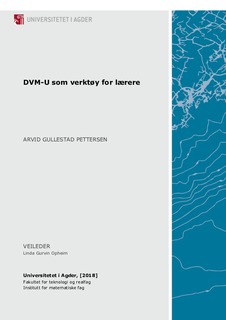| dc.description.abstract | Digital learning tools comes in different forms, and a common factor for them is that their goal
is to be a tool that helps in students learning process. For this occasion will I take a look at
«Den Virtuelle Matematikkskolen» (DVM-U) (translates to «The Virtual Mathematics
School») for students with low goal achievement. The purpose of DVM-U is described like
this: «The target is that innovative, interactive and new learning forms will stimulate the
students to perform better, and achieve higher results in the subject» (Dvm-Prosjektet, 2013)
There are also versions called DVM-1T, and DVM-Pluss for students with high goal
achievement. The DVM-U portal is made up of different learning packages, which has a
streamlined design so that students can relate structure the from package to package. DVM-U is
still running as a pilot study, and the purpose of this study is to investigate the teachers
understanding of DVM-U as a tool. Therefore, I have formulated the following research
question:
«How does the teachers experience the tool DVM-U in their teaching?»
To further describe the research question I have these questions:
• How does the teachers use DVM-U in their teaching?
• What is the teachers opinions about DVM-U in practice?
• How does the teachers experience the content of DVM-U?
The data have been collected using semi-structured interviews. Altogether four teachers who
teaches mathematics and uses DVM-U were interviewed. Three of the interviews took place in
person, and the fourth was conducted over Adobe Connect. The goals of the interviews was to
highlight the research questions. The findings were afterwards transcribed in NVivo, and a
thematic analysis was conducted with the basis in my conceptual framework which builds on
WBLR (Hadjerrouit, 2010) og A practioner’s model of the use of computer-based tools and
resources to support mathematics teaching and learning » (Ruthven & Hennessy, 2002).
From the fininds we find that teachers appreciate DVM-U, and it’s used successfully when one
teacher has the responsibility for a group of students working with DVM-U, rather than
singular working with DVM-U in a classroom.
The fininds also points out that the way DVM-U can be used, allows the students to use the
ICT more rather than pen and paper, which results in increased motivation among the students. | nb_NO |

